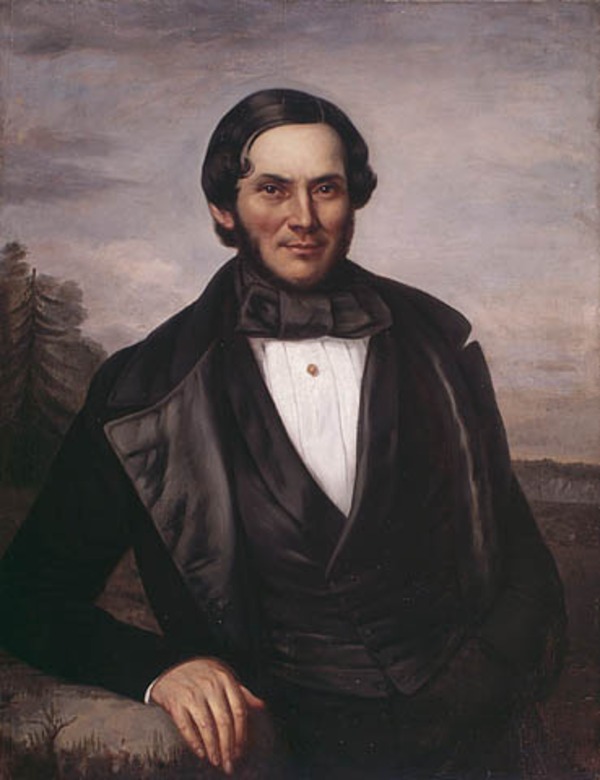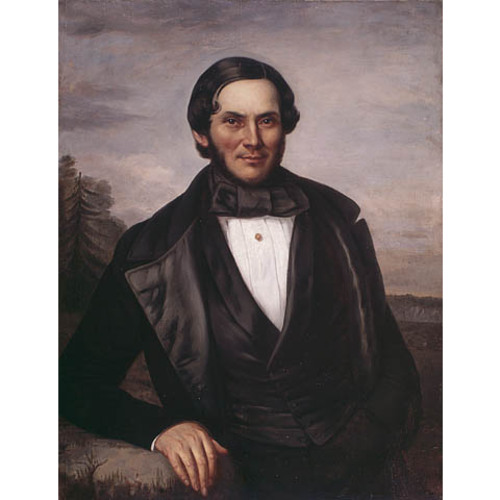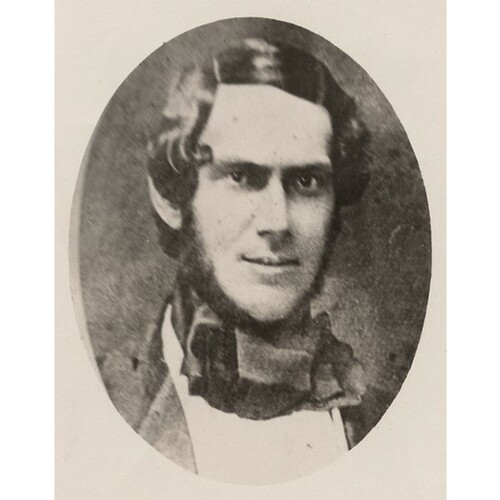McLEOD, PETER, timber contractor; b. c. 1807 most likely in Chicoutimi, Lower Canada, eldest son of Peter McLeod and a Montagnais woman; m. according to the custom of the country first Josephte Atikuapi and secondly Bélonie Siméon; two sons were born of these unions; d. 11 Sept. 1852 in Chicoutimi.
Except for a brief period of study, Peter McLeod spent his early years helping his father in the trade of various king’s posts, where he later served as a clerk from 1834 to 1836. His father, who was born in Scotland around 1784, had settled in the Saguenay region and then on the north shore of the St Lawrence at the outset of the 19th century. Engineer, surveyor, and officer in the British army, he entered the service of the North West Company, and on its merger with the Hudson’s Bay Company in 1821 he became the confidential agent of William Lampson, the lessee of the king’s posts. He occupied this position until 1831, when the HBC secured the leasing rights.
It was during his time as Lampson’s agent that McLeod Sr became interested in lumbering in the Charlevoix region. Acting virtually as a timber contractor, he built sawmills for rental in La Malbaie, served as a timber supplier, and obtained felling rights. From 1827 to 1836 he became one of the principal sources of timber for William Price*, who was then established at La Malbaie. In September 1836 he entrusted his eldest son with the responsibility for his facilities and commitments. But Peter’s assumption of control evidently did not produce very satisfactory results. From 1837 to 1842 the McLeods’ debts to Price continued to grow, and by the end of the latter year had reached £2,200. It is in the context of indebtedness, and also of Price’s desire to be the first timber contractor established as far up the Saguenay as Chicoutimi, that the partnership between Price and the McLeods must be seen.
Price could not himself acquire the felling rights and the letters patent on mill sites or on land in the region because of the prerogatives over this territory granted to the HBC until 2 Oct. 1842, and its antagonism towards him. He therefore proposed to use McLeod Jr to push farther inland along the Saguenay. With the help of the Société des Vingt et Un [see Alexis Tremblay], McLeod had established himself between Tadoussac and Grande-Baie by 1837. Since, as a Montagnais on his mother’s side, he had natural rights to circulate freely among the king’s posts and to settle there, Price would be able, through him, to thwart the HBC and achieve his goal of exploiting the region’s rich pine stands. This prospect prompted the agreement between Price and the McLeods.
The terms of the contract concluded before notary Laughlan Thomas Macpherson on 7 Nov. 1842 reveal a good deal about the intentions and interests of both parties. The assumption by the younger McLeod of managerial responsibility would discharge part of the debt he and his father owed Price. To wipe out the rest of it, Price agreed to purchase 20,000 deals from the McLeods’ sawmill on the Rivière Noire for £1,200 and then to acquire the mill. McLeod Jr was to receive a £2,000 advance in equipment and cash, so that he could lay the foundations for sawmills on the Rivière du Moulin and the Rivière Chicoutimi. McLeod undertook to acquire from the crown the property rights at the entrance to these waterways and on their banks. The agreement specified that the new facilities were the joint property of the McLeods and Price, with profits and losses to be shared equally.
McLeod never managed to get title to the two mill sites, despite a request on 26 Oct. 1842 to Sir Charles Bagot* – the matter would not be settled until 1862, ten years after McLeod’s death, when in the absence of a will or legal heirs, his estate passed to Price. But his lack of success did not stop him from setting himself up on the Rivière du Moulin and at Chicoutimi, and from launching the timber industry and settlement on the Saguenay. In August 1842, relying on his natural rights and eager to take advantage of the good season, McLeod, his wife Josephte Atikuapi, and his son John had left the Rivière Noire with 23 men to begin construction on the Rivière du Moulin. The following winter he had the “building yards going,” and he wrote to Price that lack of snow was delaying the transport of logs; he also explored Lac Kénogami and asked his partner to send him an engineer as well as equipment for building the conduit and the dam. By May, Price had met his request, and at the same time had sent him supplies for the store. A few months later, during the summer, as settlement proceeded on both banks of the Saguenay, McLeod gave permission for large areas to be cleared in the vicinity and on the slopes overlooking the settlement of Rivière-du-Moulin. He was thus able to begin sowing in the first year of his operation.
In 1844 McLeod shifted his attention to the Rivière Chicoutimi, to the west of the Rivière du Moulin. Better supplied with hydraulic power and better placed for harbour facilities, the Chicoutimi would accommodate a grist-mill and a sawmill, the first on the eastern slope and the second, set slightly back on the opposite slope, near the HBC trading post. The rivalry between the two companies and the proximity of their installations soon led to tension and clashes. Hence, to answer the HBC’s claim that the lands were an integral part of its territory, McLeod wrote to Governor Charles Theophilus Metcalfe* on 27 March 1844. His petition explained that when he arrived in the area no use was being made of these lands, and that surveyor Duncan Stephen Ballantyne, under government orders to prepare the land register, had assured him personally that they were crown lands and would be divided up for occupancy. In conclusion, McLeod informed the governor that on the strength of these arguments and of his pre-emptive right, to which he added mention of his natural privileges as an Indian and his application to purchase in 1842, he intended to remain where he was and to continue the work already begun there.
The following month Price wrote to Sir George Simpson, the HBC governor, defending his partner and asking the company to end its opposition to the plan for the sawmill. Confronted with the swift development of this establishment, which was to become the major industrial centre of the Saguenay region and indeed one of the most important in Lower Canada, the HBC was forced to give in.
Through Ballantyne’s report, drawn up in 1845, the progress of settlement and the detailed layout of the Price–McLeod establishments can be ascertained. At the Rivière du Moulin were clustered a sawmill, a wharf, a chapel, Peter McLeod’s house, the general store, stables, and the smithy, and some 20 small log houses belonging to the company. At the Chicoutimi site were a sawmill, a wharf, a three-storey warehouse, a dozen resident landowners, the foundations of a grist-mill, some properties under cultivation, a dam, and the conduits for the mill-race to power the sawmill.
These establishments were designed to be self-sufficient. At a site called La Ferme, cattle, pigs, and poultry were raised and the grains to supply the lumber yards were processed. The one general store sold everything from flour and clothes to rosaries and lumbering tools. Every Saturday the settlers-cum-lumberjacks shopped for the basic needs of their families. From 1839 to 1878 merchandise was paid for with the customary tokens (a purchasing coupon issued to the bearer and exchangeable only at the store or in the company’s office) or charged to the individual’s account. The system of payment not only made it easy to run into debt and enabled the company to strengthen its hold on the local community, but also facilitated a double form of exploitation to the extent that the employer himself determined both the salary he paid and the price of goods. As manager of the Saguenay region, McLeod made sure that the system was applied and saw that his partner’s instructions were obeyed, both in regard to tree felling and to discipline in the lumber yards.
An illustration of how rigorous the working conditions were is provided in McLeod’s letter of 3 Dec. 1846 to Damase Boulanger, one of his foremen. After outlining at length the clauses concerning the hiring of workers, McLeod gave his agent directions as to the policy to be applied in the yards: “My orders are to charge those who lose time inopportunely on account of illness five shillings per day on amounts credited [to them]. . . . Any man who disobeys the orders of the one who is paid to direct him, [and] who does not give satisfaction, shall be dismissed immediately, and shall not receive a penny of his wages. . . . I want it also to be clearly understood that any repairing . . . shall be done in the evening, after the day’s work is done. . . . Working time shall be from dawn until nightfall; the men must leave the yard before daybreak in order to be at their site as soon as it is light enough to work, and they shall not leave the site until it is too dark to continue.”
It was precisely to improve the living conditions of these men and fight the stranglehold of Price and McLeod on the local population that Jean-Baptiste Honorat*, an Oblate priest, took up the cudgels for freedom. Given responsibility by his superiors to carry out missionary work in the Saguenay, he arrived at Grande-Baie on 15 Oct. 1844. In the first two weeks he had occasion to visit Rivière-du-Moulin where, to make possible his ministry to the approximately 600 residents, he advised the settlers to build a school, which could also serve as a chapel until a church was erected. Since McLeod had planned to make this place a Protestant fief, and had engaged the services of a pastor, he naturally took a determined stand against the notion of putting up buildings. At a public meeting in December he attacked Honorat and the settlers, threatening them with reprisals if they persisted.
On 4 Jan. 1845 McLeod reversed his position. He offered to rent to Honorat and the village trustees for a five-year period the site chosen by them for the building, and quite unexpectedly even contributed £10 towards construction. An explanation for McLeod’s volte-face emerged in the ensuing months. Informing his partner of the disturbing attitude of Honorat towards the power they had acquired at Chicoutimi, McLeod asked Price to approach the archbishop of Quebec, Pierre-Flavien Turgeon*, with a request to send secular priests to take the place of the Oblates of Mary Immaculate, and to allow the chapel at Rivière-du-Moulin to be replaced by a real church to be built midway between the two settlements of Chicoutimi and Rivière-du-Moulin; this site would, he thought, encourage the influx of new settlers and the development of a single village. In the spring of 1845 Price hastened to have a meeting with Turgeon on the matter. On 24 Feb. 1846, after negotiations with Honorat’s provincial, Father Joseph-Bruno Guigues*, the archbishop gave his agreement to the request of Price and McLeod.
Honorat decided, in the face of the tactics being used to dislodge him and his community from the Saguenay, to “liberate” the settlers from the iron rule of Price and McLeod by giving them access to landed property. In May 1846, relying on European experience, he founded the mission of Grand-Brûlé (Laterrière). The plan to set up a free agricultural colony on the Saguenay quickly attracted the attention of the settlers and at the same time aroused the apprehension of Price and McLeod. The scheme contravened the interests of the two men because it involved displacing the population, was based on both agriculture and lumbering, and cut off the sawmills of the Rivière du Moulin and the Rivière Chicoutimi from their natural sources of timber. Since their monopoly in the Saguenay region would likely be jeopardized, they reacted swiftly.
On 3 March 1849 McLeod drew up a protest against Honorat before a notary, accusing him of having diverted some settlers of Grand-Brûlé from the contracts they had entered into with him. Subsequently, Price and McLeod developed a strategy designed to oust Honorat permanently from the Saguenay region. They also claimed that his undertaking was competing with their business and was leading the Oblates to certain failure. They accused him of taking too much interest in social questions and causing his community, the clergy, indeed the entire church, to be disliked because of his lack of consideration for the local Protestant élite. Thus they forced his superiors to recall him. In August 1849 Honorat quit the Saguenay in despair, leaving the people to the mercy of Price and McLeod.
Having no legal or political means to make themselves heard, the settlers were once more submitted to McLeod’s yoke. From 1848 to 1850 he maintained his control of the timber trade and devoted some of his energies to amassing wealth in the form of land. In return for mortgages on the settlers’ lands, he advanced to them equipment and provisions from his general store; he used the law to expel settlers from the land they had cleared and sown when they did not hold a location ticket. On 29 Sept. 1849 McLeod’s special attorney went before the government investigator, Jacques Crémazie*, to explain these dispossessions. In his report of 20 Feb. 1850 Crémazie pointed out the tactics used by McLeod, and made recommendations to correct the situation. These recommendations were not, however, put into effect until the next decade.
During the years 1849 and 1850 the Canadian timber trade enjoyed a strong recovery after the 1846 crisis precipitated by Britain’s abolition of the tariffs protecting the colony, and by the slump in the market. On his partner’s behalf, McLeod set up new sawmills as he took the first steps towards the conquest of the Lac-Saint-Jean region. But Price was alarmed about McLeod’s health, and no longer felt that the 1842 contract was a sufficient guaranty, since there were no title deeds to the Rivière-du-Moulin and Chicoutimi establishments. Thus he decided in 1848 to undertake nothing further with McLeod unless a notarized contract was signed every autumn. On 21 Oct. 1850 Price submitted a request that the partnership with the McLeods be dissolved. On 2 November, as their debt to him was estimated at £4,520, he took a mortgage on the sawmill on the Chicoutimi and on the lands attached to it. When McLeod died suddenly on 11 Sept. 1852 and the legitimacy of his two sons, 16-year-old John and 5-year-old François, could not be established, Price, as creditor and trustee of the estate, became the sole owner of the establishments in the Saguenay and the largest timber merchant in Lower Canada.
Peter McLeod’s acts of generosity, particularly towards Indians, which are occasionally noted in archival records, should not be forgotten. Nor should his influence and hold on the local population be underestimated. None the less, despite the legend surrounding him, he remains the figurehead of William Price, the partnership of 1842 condemning him to play second fiddle. Disadvantaged by the agreement that joined him to Price, he died more in debt than ever, leaving to his partner a booming industry and a region rich in resources to be developed.
ANQ-Q, CN1-197, 7 nov. 1842; CN4-9, 3 oct. 1828, 14 sept. 1829, 19 avril 1836; CN4-19, 25 juill. 1842; P1000-25-456. ANQ-SLSJ, P-2, Dossier 2, pièce 40; Dossier 3, pièce 14; Dossier 19, pièce 28; Dossier 645. Price Company Limited Arch. (Chicoutimi, Que.), Corr., Peter McLeod to William Price, 26 Jan. 1843, 27 Jan. 1844; Peter McLeod to C. T. Metcalfe, 27 March 1844; William Price to George Simpson, 16 April 1844. Arthur Buies, Le Saguenay et le bassin du lac Saint-Jean; ouvrage historique et descriptif (3e éd., Québec, 1896). Louise Dechêne, “William Price, 1810–1850” (thèse de licence, univ. Laval, Québec, 1964). Damase Potvin, Peter McLeod, grand récit canadien inédit (Québec, 1937). Arthur Maheux, “Le cas de Peter McLeod, jr.,” Concorde (Québec), 6 (1955), no.5: 24. J.-P. Simard, “Biographie de Thomas Simard,” Saguenayensia (Chicoutimi), 20 (1978): 4–7; “Onze années de troubles dans les postes du roi, 1821–1831,” 10 (1968): 2–6.
Cite This Article
Gaston Gagnon, “McLEOD, PETER,” in Dictionary of Canadian Biography, vol. 8, University of Toronto/Université Laval, 2003–, accessed April 10, 2025, https://www.biographi.ca/en/bio/mcleod_peter_8E.html.
The citation above shows the format for footnotes and endnotes according to the Chicago manual of style (16th edition). Information to be used in other citation formats:
| Permalink: | https://www.biographi.ca/en/bio/mcleod_peter_8E.html |
| Author of Article: | Gaston Gagnon |
| Title of Article: | McLEOD, PETER |
| Publication Name: | Dictionary of Canadian Biography, vol. 8 |
| Publisher: | University of Toronto/Université Laval |
| Year of revision: | 1985 |
| Access Date: | April 10, 2025 |





